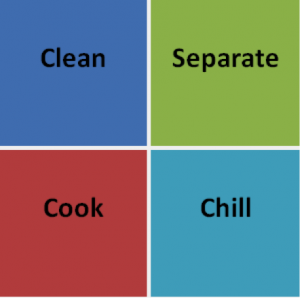 As noted previously, keeping our people safe from food poisoning is one of the most important responsibilities we have as homemakers. To help you accomplish that objective, the federal government has condensed the current best-practices of food safety into Four Simple Steps: Clean, Separate, Cook and Chill. Here are a few brief samples of what you will find when you go to the website:
As noted previously, keeping our people safe from food poisoning is one of the most important responsibilities we have as homemakers. To help you accomplish that objective, the federal government has condensed the current best-practices of food safety into Four Simple Steps: Clean, Separate, Cook and Chill. Here are a few brief samples of what you will find when you go to the website:
1) Clean—“Unless you wash your hands, utensils, and surfaces the right way, you could spread bacteria to your food, and your family.”
- Explains proper procedures for washing hands, surfaces, utensils and foods. Read more at: http://www.foodsafety.gov/keep/basics/clean/index.html and be sure to watch the fun “Clean” video located in the right-hand margin.
2) Separate—“…raw meat, poultry, seafood, and eggs can still spread illness-causing bacteria to ready-to-eat foods—unless you keep them separate…”
- Learn how to keep foods safely separate while grocery shopping, during meal preparation and in your fridge. Go to: http://www.foodsafety.gov/keep/basics/separate/index.html for more information and to watch another video.
3) Cook—“…bacteria that cause food poisoning multiply quickest in the “Danger Zone” between 40 and 140 degrees Fahrenheit…there’s no way to be sure [food is] safe without following a few important but simple steps.”
- Discover how to properly use a food thermometer, ways to keep food hot (and out of the “Danger Zone”) after cooking, and safely microwave food (to 165 degrees F). Click on “Expand” at: http://www.foodsafety.gov/keep/basics/cook/index.html for further explanations and another clever video
4) Chill—“…illness-causing bacteria can grow in perishable foods within two hours unless you refrigerate them…( [or 1 hour] if temperature is 90 degrees F or higher during the summer)…By refrigerating foods promptly and properly, you can help keep your family safe from food poisoning at home.
- Understand how to chill your foods promptly and properly, why it is inadvisable to marinate or thaw foods at room temperature on the counter, and when you should throw out food. There is also a “Safe Storage Times” chart located further down on the page at: http://www.foodsafety.gov/keep/basics/chill/index.html.
